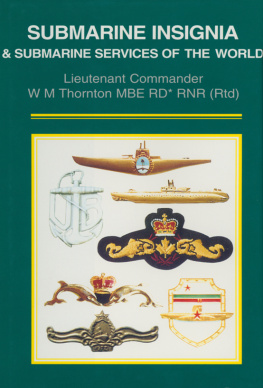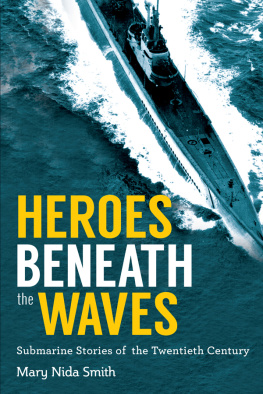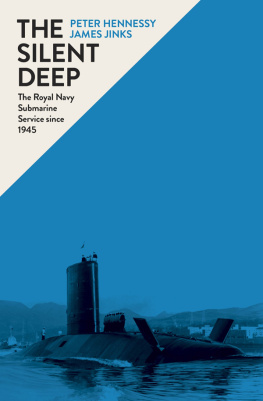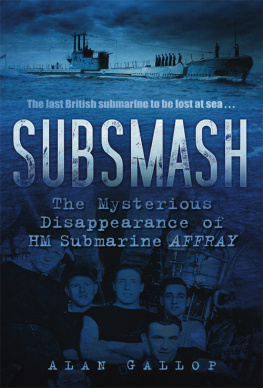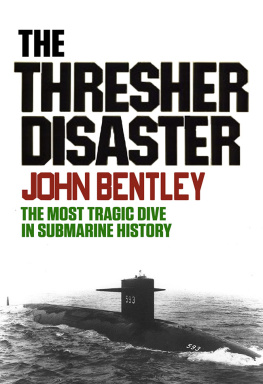Polmar - The death of the USS Thresher
Here you can read online Polmar - The death of the USS Thresher full text of the book (entire story) in english for free. Download pdf and epub, get meaning, cover and reviews about this ebook. City: United States, year: 2001;2004, publisher: Lyons Press, genre: Romance novel. Description of the work, (preface) as well as reviews are available. Best literature library LitArk.com created for fans of good reading and offers a wide selection of genres:
Romance novel
Science fiction
Adventure
Detective
Science
History
Home and family
Prose
Art
Politics
Computer
Non-fiction
Religion
Business
Children
Humor
Choose a favorite category and find really read worthwhile books. Enjoy immersion in the world of imagination, feel the emotions of the characters or learn something new for yourself, make an fascinating discovery.

- Book:The death of the USS Thresher
- Author:
- Publisher:Lyons Press
- Genre:
- Year:2001;2004
- City:United States
- Rating:4 / 5
- Favourites:Add to favourites
- Your mark:
- 80
- 1
- 2
- 3
- 4
- 5
The death of the USS Thresher: summary, description and annotation
We offer to read an annotation, description, summary or preface (depends on what the author of the book "The death of the USS Thresher" wrote himself). If you haven't found the necessary information about the book — write in the comments, we will try to find it.
Polmar: author's other books
Who wrote The death of the USS Thresher? Find out the surname, the name of the author of the book and a list of all author's works by series.
The death of the USS Thresher — read online for free the complete book (whole text) full work
Below is the text of the book, divided by pages. System saving the place of the last page read, allows you to conveniently read the book "The death of the USS Thresher" online for free, without having to search again every time where you left off. Put a bookmark, and you can go to the page where you finished reading at any time.
Font size:
Interval:
Bookmark:
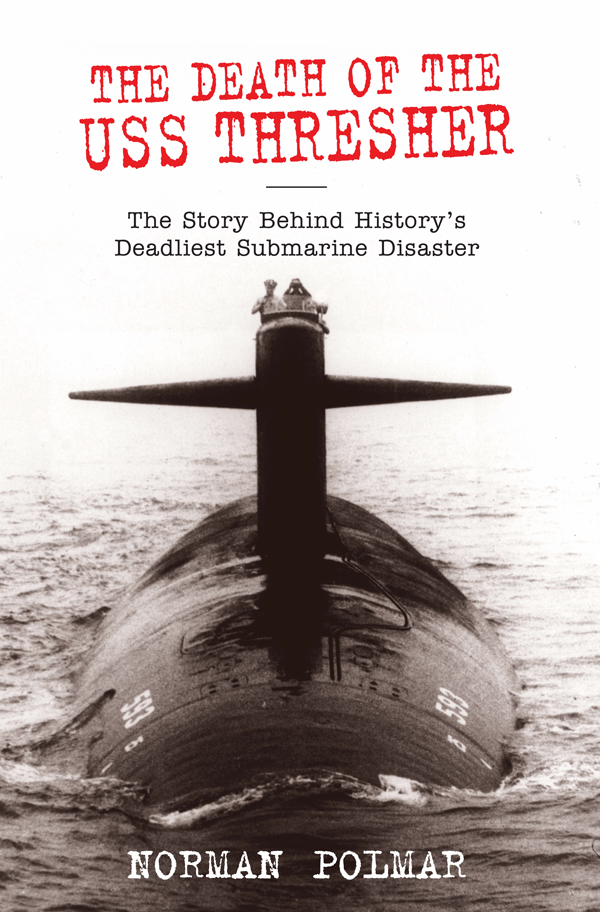
THE DEATH OF THE USS THRESHER
THE DEATH OF THE USS THRESHER
Norman Polmar

The Lyons Press
Guilford, Connecticut
An imprint of The Globe Pequot Press
To the Officers and Enlisted Men of the United States Ship Thresher, who went to sea in her on April 9, 1963,
and
John Slinkman, my editor, mentor, and friend,
who told me to write about the Thresher .
Copyright 1964, 2001, 2004 by Norman Polmar
All illustrations, unless otherwise indicated, are official U.S. Navy photographs.
Originally published by Chilton Books, A division of Chilton Company
All Rights Reserved. No part of this book may be reproduced or transmitted in any form by any means, electronic or mechanical, including photocopying and recording, or by any information storage and retrieval system, except as may be expressly permitted in writing from the publisher. Requests for permission should be addressed to The Lyons Press, Attn: Rights and Permissions Department, P.O. Box 480, Guilford, CT 06437.
The Lyons Press is an imprint of the Globe Pequot Press.
Design by Compset, Inc.
The Library of Congress has catalogued the 1-58574-348-8 edition as follows: Catalogue Card Number 64-15134
E-ISBN 978-0-7627-9613-7
CONTENTS
Appendixes
The man who ventures to write contemporary history must expect to be criticized both for everything he has said and everything he has not said.
Voltaire
in a letter to M. Bertin de Rocheret
PREFACE
In the eerie pre-dawn light of an April morning, a huge black shape rested in the waters that washed the shores of Portsmouth, New Hampshire. Clustered on that shore were scores of buildings that, less than two years before, had been the birthplace of the black mass of steel that now lay tethered to the shore by steel cables and a wooden pier.
Before the first rays of sunlight touched down on the black submarine or the nearby buildings, a strange light began to glow deep in the bowels of the submarine. Inside the lead-lined reactor, nuclear fissionthe same power that fired the sunfired a maze of machinery inside the strange craft. Human beingsmore than one hundred of themturned valves and threw switches that seemingly brought the black shape to life. Thus the uss Thresher came alive on the morning of April 9, 1963.
The men of the submarines anchor detail cast off the steel cables that tied her to shore and slowly headed down river and into the great ocean beyond. On the bridge atop the submarines sail structure a young officer carefully surveyed the ship he commanded. He listened with confidence to the sounds of the men working inside his ship and the sounds of water rushing by the ships hull.
The ship was the most advanced attack nuclear submarine ever built. Her sonar could probe out enemy submarines at greater distances than ever before. The new torpedo-missile weapon system planned for her would kill enemy submarines faster and at greater distances than ever before. The Thresher herself was ultra-silent when operating in the depths, making her relatively immune to enemy detection devices. And the Thresher , by operating in depths far beyond the reach of most enemy weapons, would be shrouded in a mantle of immunity. Nine months in the Portsmouth Naval Shipyard had tuned up the Thresher , eliminating what bugs had been found in her design and construction.
On April 9 the Thresher made a successful dive to relatively shallow depths in the waters off New England. She then headed out to deep water for a dive to her maximum operating or test depth. On the morning of April 10 she slowly descended. Some forty times before she had gone down to such a depth and returned safely.
This time the Thresher did not return to the surface.
The Thresher and the 129 men in herdied on the morning of April 10. It was the worst submarine disaster to that time. In the ensuing decades no fewer than six additional nuclear submarines would be lost at sea, one American, the uss Scorpion , and five Soviet-Russian. But the Thresher would remain the most tragic sinking in number of men killed, and she would have the dubious distinction of being the first nuclear submarine to be lost.
This book is the story of the Thresher , her beginning, her short career, and her death. It is the story of a magnificent submarine, an outstanding crew, and the worst submarine disaster in history.
The description of what went on inside the Thresher during her final hours is drawn together from men who were intimately familiar with the Thresher and men who earlier sailed in her. Indeed, the commanding officer who took the Thresher down on her first dive to test depthand halted the dive because of the possibility that the Thresher was diving to disasterhas been kind enough to help me with this project. He and the others who contributed to this book are listed in the acknowledgments.
Submarines are known by many termssome flattering, some not so. Traditionally they are called boats. In the nuclear age their size and cost almost dictates that they be properly labeled ships. The terms are used interchangeably by submariners and I use them here as they were spoken and written.
N ORMAN P OLMAR
ACKNOWLEDGMENTS
This book was originally written because of Thomas B. Allen, then managing editor of Chilton Books, which published the first edition of Death of the Thresher in 1964. Mr. Allen and I subsequently have collaborated in writing seven books and numerous articles.
The original book was written with the extensive help of many individuals, but especially Captain Dominic A. Paolucci, one of the Navys outstanding submariners. He was a 1943 graduate of the Naval Academy and held the degree of Doctor of Philosophy in mathematics from Indiana University. Captain Paolucci was most familiar with Thresher- class submarines: From 1958 to 1961 he was head of the submarine training and policy section in the Office of the Chief of Naval Operations; from 1961 to 1963 he helped plan the integration of Thresher -class submarines into the Pacific Fleet while on the staff of the Commander, Submarine Force, Pacific Fleet; in July, 1963 he took command of Submarine Division 71, consisting of five nuclear-powered submarines, two of them sisters to the Thresher . Following his retirement from the Navy in 1969 he and I worked together in the corporate world for ten years.
I was also greatly in debt to Rear Admiral Dean L. Axene, the first commanding officer of the Thresher , and to Rear Admiral David M. Cooney, at the time head of the magazine and book section of Navy Information. Both contributed much time and effort to this project.
This revised addition benefited from the comments of Robin Pirie, former commanding officer of the nuclear-propelled submarine Skipjack , Assistant Secretary of Defense, Under Secretary of the Navy, and acting Secretary of the Navy.
In writing the original book, Dr. Arthur E. Maxwell of the Office of Naval Research aided in writing about the search phase of the Thresher story; Lieutenant Commander Don Keach, former skipper of the bathyscaph Trieste , provided details of his dives in search of the Thresher ; Commander John H. Nicholson, a veteran nuclear submariner, helped with technical details of the Thresher ; Captain Tazewell T. Shepard Jr., former Naval Aide to the President, described events at the White House on April 10, 1963; Captain H. B. Sweitzer, former aide to the Vice Chief of Naval Operations, provided details of the events in the Pentagon on April 10, 1963; Commander Howard N. Larcombe, commanding officer of the uss Dogfish , furnished details of the Thresher s departure on her last cruise; and Lieutenants Don Walsh and Lawrence Shumaker, the first Navymen assigned to the bathyscaph Trieste , educated me in her ways.
Font size:
Interval:
Bookmark:
Similar books «The death of the USS Thresher»
Look at similar books to The death of the USS Thresher. We have selected literature similar in name and meaning in the hope of providing readers with more options to find new, interesting, not yet read works.
Discussion, reviews of the book The death of the USS Thresher and just readers' own opinions. Leave your comments, write what you think about the work, its meaning or the main characters. Specify what exactly you liked and what you didn't like, and why you think so.


